Related Research Articles
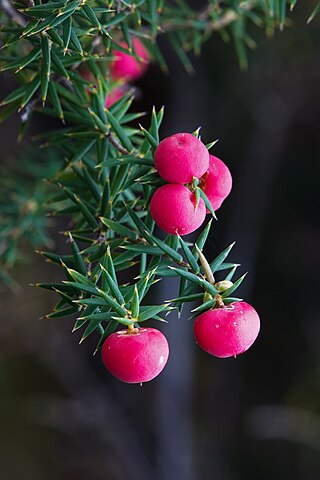
The Ericaceae are a family of flowering plants, commonly known as the heath or heather family, found most commonly in acidic and infertile growing conditions. The family is large, with c. 4250 known species spread across 124 genera, making it the 14th most species-rich family of flowering plants. The many well known and economically important members of the Ericaceae include the cranberry, blueberry, huckleberry, rhododendron, and various common heaths and heathers.

Leucopogon is a genus of about 150-160 species of shrubs or small trees in the family Ericaceae, in the section of that family formerly treated as the separate family Epacridaceae. They are native to Australia, New Zealand, New Caledonia, the western Pacific Islands and Malaysia, with the greatest species diversity in southeastern Australia. Plants in this genus have leaves with a few more or less parallel veins, and tube-shaped flowers usually with a white beard inside.

Epacris is a genus of about forty species of flowering plants in the family Ericaceae. It was formerly treated in a closely related but separate family Epacridaceae, but the various genera within Epacridaceae including Epacris have been revised in their relationships to each other and brought under the common umbrella of the Ericaceae. The genus Epacris is native to eastern and southeastern Australia, New Caledonia and New Zealand. The species are known as heaths or Australian heaths.

Bossiaea is a genus of about 78 species of flowering plants in the pea family Fabaceae and is endemic to Australia. Plants in this genus often have stems and branches modified as cladodes, simple, often much reduced leaves, flowers with the upper two sepal lobes larger than the lower three, usually orange to yellow petals with reddish markings, and the fruit a more or less flattened pod.

Woollsia is a monotypic genus in the family Ericaceae. The sole species, Woollsia pungens, known as snow heath, is a small shrub found in eastern Australia, from Pigeon House Mountain in southern New South Wales north into Queensland.

Styphelia is a genus of shrubs in the family Ericaceae, native from Indo-China through the Pacific to Australia. Most have minute or small leaves with a sharp tip, single, tube-shaped flowers arranged in leaf axils and with the ends of the petals rolled back with hairs in the inside of the tube.

Epacris microphylla , commonly known as coral heath, is a plant in the heath family Ericaceae and which is endemic to eastern Australia. It is a common, wiry shrub with tiny leaves that are often obscured by the flowers, especially near the ends of the stems. The plant sometimes grows in dense groups, giving the effect of a snowfall.
Budawangia is a monotypic genus of flowering plants in the family Ericaceae. The sole species is Budawangia gnidioides from New South Wales. The genus was formally described in 1992.

Epacris rhombifolia commonly known as mountain coral heath, is a plant in the heath family Ericaceae and is endemic to eastern Australia. It is an erect, multi-stemmed shrub with broad, rhombic leaves and white flowers with four petals, the flowers spreading down the branches. It only grows in wet, subalpine heath and is sometimes regarded as a variety of Epacris microphylla.
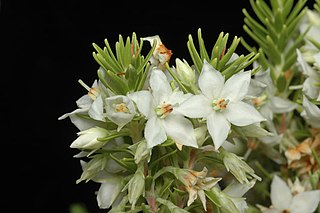
Epacris sprengelioides is a species of flowering plant in the family Ericaceae and is endemic to a small area in the Blue Mountains in New South Wales. It is an erect shrub with shaggy-hairy branchlets, more or less erect, narrowly elliptic leaves, and white or cream-coloured, tube-shaped flowers.

Styphelia planifolia is a species of flowering plant in the heath family Ericaceae and is endemic to the south-west of Western Australia. It is a bushy shrub with narrowly oblong or lance-shaped leaves with a small, sharp point on the tip, and white, tube-shaped flowers.

Epacris gnidioides, commonly known as Budawangs cliff-heath, is a species of flowering plant in the heath family Ericaceae and is endemic to a restricted area of New South Wales. It is a small, creeping shrub with hairy branches, sharply-pointed lance-shaped leaves, and tube-shaped, white flowers.

Styphelia stomarrhena is a small shrub species in the family Ericaceae. It is found in Western Australia.
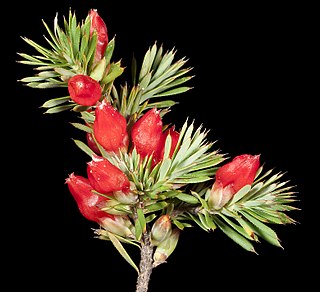
Styphelia tortifolia is a small shrub species in the family Ericaceae. It is found in Western Australia.
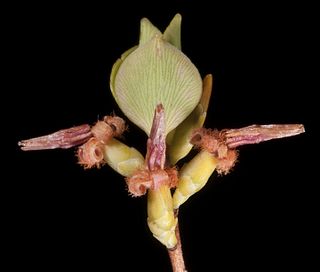
Coleanthera is a plant genus in the family Ericaceae. The genus is endemic to Western Australia, and is currently accepted by Plants of the World online, and the Council of Heads of Australasian Herbaria, but not by the Western Australian Herbarium, where it has been subsumed into the genus, Styphelia, for the phylogenetic reasons given by Darren M. Crayn, Michael Hislop and Caroline Puente-Lelièvre.
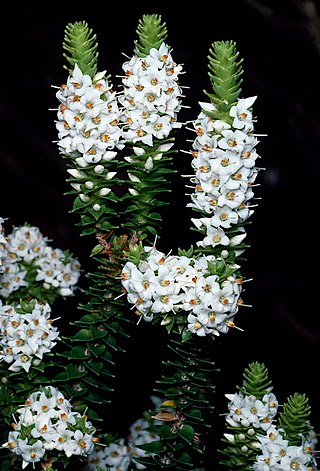
Epacris apiculata is a species of flowering plant in the heath family Ericaceae and is endemic to a small area of New South Wales. It is a small, slender, low-lying to erect shrub with hairy branchlets, egg-shaped leaves with a thickened, pointed tip and tube-shaped flowers with white petals.

Epacris decumbens is a species of flowering plant in the heath family Ericaceae and is endemic to a restricted area of New South Wales. It is a straggling, low-lying shrub with hairy branchlets, elliptic to egg-shaped leaves, and tube-shaped, white flowers.
Epacris pilosa is a species of flowering plant in the heath family Ericaceae and is endemic to eastern New South Wales. It is low-lying shrub with weeping, shaggy-hairy branchlets, elliptic to more or less egg-shaped leaves and white or cream-coloured tube-shaped flowers.

Epacris purpurascens is a species of flowering plant in the heath family Ericaceae and is endemic to eastern New South Wales. It is an erect shrub with egg-shaped or heart-shaped, sharply-pointed leaves and white or pink, tube-shaped flowers.

Epacridoideae is a subfamily of the family Ericaceae. The name StyphelioideaeSweet is also used. The subfamily contains around 35 genera and 545 species. Many species are found in Australasia, others occurring northwards through the Pacific to Southeast Asia, with a small number in South America.
References
- 1 2 "Rupicola". Australian Plant Name Index (APNI), IBIS database. Centre for Plant Biodiversity Research, Australian Government, Canberra. Retrieved 3 March 2012.
- ↑ "Genus Rupicola". PlantNET - New South Wales Flora Online. Royal Botanic Gardens & Domain Trust, Sydney Australia. Retrieved 3 March 2012.
- 1 2 3 4 5 Quinn, Christopher J.; Crowden, Ronald K.; Brown, Elizabeth A.; Southam, Michael J.; Thornhill, Andrew H.; Crayn, Darren M. (10 September 2015). "A reappraisal of the generic concepts of Epacris, Rupicola and Budawangia (Ericaceae, Epacridoideae, Epacrideae) based on phylogenetic analysis of morphological and molecular data". Australian Systematic Botany. 28 (1): 63–77. doi:10.1071/SB13009. ISSN 1446-5701. S2CID 85849925. (DOI paywalled, proof copy at .)
- ↑ "Epacris". Australian Plant Census. Retrieved 24 June 2022.
- 1 2 3 4 5 6 Telford, Ian R. H. (30 September 1992). "Budawangia and Rupicola, new and revised genera of Epacridaceae". Telopea. Sydney: Royal Botanic Gardens and Domain Trust. 5 (1): 229–239. doi: 10.7751/telopea19924966 . ISSN 0312-9764.
- 1 2 3 Maiden, J. H.; Betche, E. (1898). "Notes from the Botanic Garden, Sydney. No. 3". Proceedings of the Linnean Society of New South Wales. 23: 772–779.Rupicola is on pages 774–775 and plate xxviii (five figures). [Online copies from MBWHOI digitisation: IA pp. 774–775, BHL, WM Commons p. 774.]
Further references not sighted:
- Summerhayes, V. S. (1927) XXXIX, - Decades Kewenses - Plantarum novarum in herbario horti regii conservatarum. Decas CXVIII. Kew Bull. for 1927: 356–363. JSTOR: DOI 10.2307/4107644 https://www.jstor.org/stable/4107644 (login required).